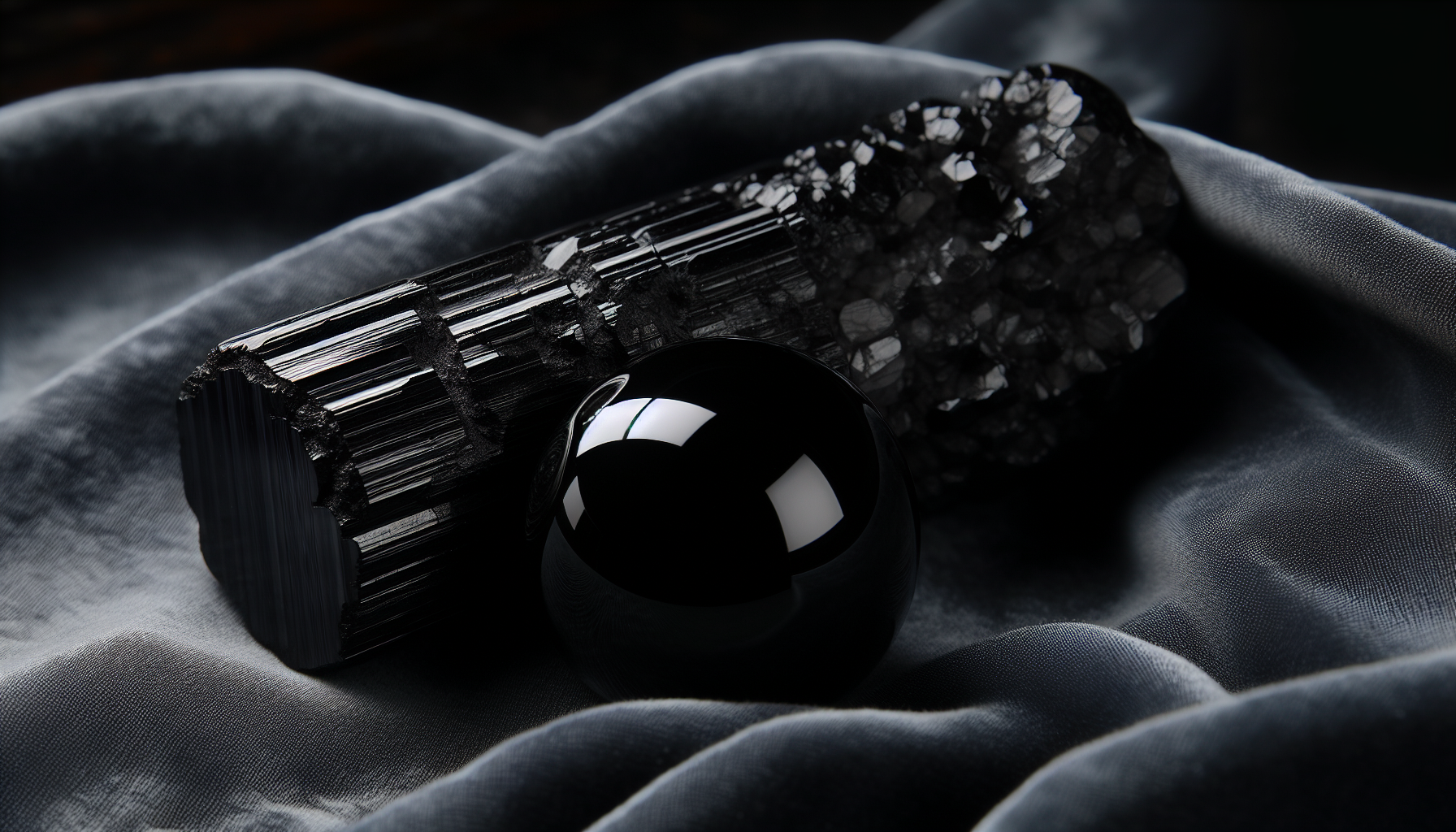Obsidian and black tourmaline have distinct origins & properties. Obsidian is volcanic glass formed from rapidly cooled lava, while black tourmaline is a mineral crystal formed in the Earth’s crust from hydrothermal activities.
Both black tourmaline and obsidian have protective metaphysical properties; black tourmaline is believed to protect from negative energies and help with grounding, while obsidian is considered a grounding stone that also offers deep cleansing of negative energies.
While both stones are used for jewelry and decoration, they differ in hardness with black tourmaline being more durable (7-7.5 on the Mohs scale) compared to obsidian (5-5.5 on the Mohs scale), affecting how they should be handled and cared for.
If you’re torn between “black tourmaline vs obsidian”, you’re likely seeking clarity on their differences and which might serve your purposes best. This article cuts right to the chase, contrasting the deep grounding abilities of black tourmaline with the cleansing power of obsidian. Get ready for an enlightening exploration of their origins, physical properties, and metaphysical significance that will help you determine which stone is your ideal match in the black tourmaline vs obsidian debate.
Unveiling the Origins: Volcanic Glass vs Mineral Crystal

Picture the intense heat and dynamic energy of a volcano in eruption, as molten lava cools rapidly upon meeting the cooler earth or water. This marks the dramatic birth of obsidian, a naturally occurring volcanic glass known for its:
- glossy appearance
- smooth texture
- sharp edges
- dark color
In contrast, the creation of raw black tourmaline embarks us on a unique journey into the depths of the Earth’s crust where hydrothermal activities birth this distinct crystal. The beauty of these stones lies not only in their physical attributes but also in their fascinating geological stories, including the formation of tumbled black tourmaline.
Black tourmaline, also known as Schorl, is a well-liked black crystal variant recognized for its unique structure of elongated three-sided prismatic crystal columns. Its black hue is attributed to the presence of iron. This captivating stone is primarily found in:
- Southern California
- China
- Brazil
- Tanzania
Conversely, obsidian is typically found in regions with volcanic histories, such as Canada, Italy, and Argentina. The formation process lends obsidian a smooth, shiny, and glass-like surface that can appear translucent and transparent along its sharp edges under bright light. Although both stones are primarily black, their unique formation processes and inherent properties create an intriguing contrast that sets them apart.
From Molten Lava to Glassy Splendor
The creation of obsidian, a kind of volcanic glass, is a story of fire meeting ice. Molten lava, upon rapidly cooling when it encounters cooler land or water, gives birth to this glassy wonder. The rapid cooling inhibits crystal formation, leading to the solidification of lava into an amorphous structure that imparts obsidian with its unique glass-like properties. Obsidian is rich in silica, which lends to its glassy appearance. Its formation process imbues it with a certain energetic quality, setting it apart from other stones like black tourmaline.
However, it’s not just obsidian’s birth that makes it fascinating. Its physical appearance is equally captivating. The smooth, shiny surface of obsidian is a testament to its volcanic origins. Its glass-like luster, along with color variations ranging from dark browns to blacks, makes it a visually appealing stone. These color variations are influenced by impurities within the crystal, with iron and iron oxide impacting coloration.
The Birth of Black Tourmaline
While obsidian forms quickly, the creation of black tourmaline is a geological story that unfolds gradually over time. This black crystal owes its existence to the complex hydrothermal process, which involves the circulation of hot, mineral-rich fluids through the Earth’s crust. These fluids trigger chemical reactions and mineral deposition, eventually forming black tourmaline. This stone is typically found in igneous and metamorphic rocks under high temperature and pressure conditions, where it crystallizes from mineral-rich solutions within the rocks’ fractures and cavities.
Black tourmaline, classified within the silicate group of minerals, is often linked to elements including boron, aluminum, silicon, and various trace elements. Its physical characteristics, such as its vitreous luster and opaque texture, are a stark contrast to the smooth, glassy luster of obsidian. Interestingly, despite these differences, both black tourmaline and obsidian can be found in polished forms, often used for jewelry and decorative purposes.
Contrasting Appearances: Identifying Physical Characteristics

As we explore more about black tourmaline and obsidian, their physical attributes present an intriguing study of contrasts. The rough, lumpy surface of black tourmaline, even when polished, is a world away from the smooth shards of obsidian. Yet, both these stones share the same captivating black hue, albeit with unique nuances that set them apart.
Black tourmaline, with its glass-like appearance and slight reflectiveness, is opaque. Upon a more detailed examination, one might notice small fissures, cracks, and colored veins that are unique to this stone. Obsidian, on the other hand, is recognized for its very smooth, shiny, and glassy-looking surface. It typically displays a conchoidal fracture, characterized by a curved break-off point when the stone is chipped. The color variations in obsidian, influenced by impurities within the crystal, range from dark browns to blacks. The way these stones play with light, their distinct textures, and the subtle color variations all contribute to their unique identities.
The Hue Spectrum: Beyond Black Color
Even though black is the predominant color, both obsidian and tourmaline exhibit a range of hues that extends beyond their dark exterior. Obsidian exhibits a range of colors including dark browns, mahogany, snowflakes, golden, green, blue, and reddish hues. Tourmalines can be observed in shades of pink, yellow, blue, or a combination of these with black.
The black color in obsidian is a result of its composition, which includes the presence of impurities. On the other hand, black tourmaline appears black due to its pyroelectric properties and high iron content, which allows it to absorb most wavelengths of light. The color variations in obsidian are attributed to oxidized iron nanoparticles and other impurities and inclusions within its structure. Meanwhile, in black tourmaline, the color differences primarily stem from the concentration of iron, which influences its darkness.
Shape and Texture: Prisms vs Sharp Edges
The raw form and texture of black tourmaline and obsidian are as diverse as their origins. Black tourmaline, in its rough form, is known for its prismatic and columnar shape, distinguished by elongated crystals with a triangular cross-section and parallel striations. Obsidian, however, forms in smooth shards, with sharp edges resulting from its fracture pattern, similar to glass. The contrast in their shapes makes them easily distinguishable to the discerning eye.
Obsidian’s smooth, glassy texture is a testament to its formation process, while black tourmaline exhibits an opaque texture with a vitreous luster. The play of light on these textures further enhances their beauty, making them alluring choices for jewelry and decorative pieces.
Harnessing the Power: Metaphysical Properties and Uses

Beyond their impressive appearances, black tourmaline, black agate, black onyx, and obsidian, collectively known as black stones, also possess notable metaphysical properties. Renowned among healers and spiritual seekers, these stones are believed to possess protective and healing qualities.
Black tourmaline, often referred to as the protector against energy vampires, is believed to:
- Protect from low vibrational entities
- Ground the individual
- Ease anxiety
- Rebalance the body
- Remove disruptive energy
- Provide energetic protection for empaths.
Obsidian, on the other hand, is noted for its powerful grounding, deep negative energy cleansing, and strong psychic protection. While obsidian primarily repels negative energy, black tourmaline can absorb it, making obsidian a blocker and black tourmaline a container that requires frequent cleansing. These unique attributes make black tourmaline and obsidian valuable companions in spiritual practices and energy work.
Black Tourmaline: The Protector Against Energy Vampires
Black tourmaline holds a special position among metaphysical stones because of its protective properties. It is renowned for its ability to:
- Shield against negative energies
- Protect against energy vampires – those who unconsciously drain others of their energy
- Repel and block detrimental influences
- Assist in dispelling various forms of negativity
Not only does black tourmaline provide energetic protection, but it also offers physical benefits by easing anxiety, panic attacks, and other conditions related to the nervous system, contributing to overall physical well-being. It can be carried, worn as jewelry, or strategically placed in one’s living or working environment to establish a shield of protection.
Obsidian: Mirror to the Soul for Self Reflection
While black tourmaline performs a protective role, obsidian acts as a mirror, reflecting inner truths and fostering self-reflection and spiritual growth. Its smooth, reflective surface amplifies self-awareness, facilitating self-reflection, thereby assisting in the practice of personal introspection. This makes obsidian a valuable tool in meditation practices, where the stone can:
- Enhance mental acuity
- Encourage introspection
- Enable individuals to address their deepest thoughts and emotions
- Foster self-exploration and spiritual development
Obsidian can be used in various ways:
- It can be strategically positioned on or near the body for emotional and physical healing.
- It can be used for astral travel or meaningful dreams by placing it beneath the pillow or on the bedside table.
- It can be used to release emotional, physical, and spiritual blockages and draw out stress and tension.
Its metaphysical attributes have led to obsidian being widely recognized as the ‘stone of truth’, making it particularly suitable for individuals seeking to engage in self-exploration and spiritual awakening.
Durability and Care: Maintaining Your Stones

While black tourmaline and obsidian are certainly captivating, it’s also vital to comprehend their durability and care requirements to preserve their shine and efficacy. Both stones, while robust, differ in their hardness ratings on the Mohs scale, an aspect that influences their durability and handling. Black tourmaline, with a hardness rating of 7-7.5, indicates high durability against scratches and general wear, while black obsidian, with a softer rating of 5-5.5, requires more cautious handling.
You can effectively clean both black tourmaline and obsidian by rinsing them under running water or wiping them with a damp cloth. Additionally, the use of detergent is acceptable for a more thorough cleaning when needed. However, it’s not just the physical cleansing that’s important. As these stones absorb low vibrations over time, they need to be cleared of negative energies regularly to maintain their protective qualities.
Toughness on the Mohs Scale
The Mohs scale measures the hardness of minerals using ten reference minerals to determine the relative hardness of minerals and other substances. Black tourmaline registers a hardness of 7-7.5 on this scale, indicating higher durability and lesser susceptibility to scratches.
On the other hand, obsidian has a hardness of 5.5 on the Mohs scale, which suggests that it requires more careful handling. Despite its susceptibility to scratches, obsidian remains suitable for a range of applications, including:
- jewelry making
- decorative objects
- cutting tools
- arrowheads
- mirrors
Keeping the Energy Clean
Preserving the energy of black tourmaline and obsidian is equally important as their physical maintenance. Various techniques can be employed to purify these stones, such as:
- Water cleansing
- Light charging
- Utilizing clear quartz or selenite
- Sound cleansing with bells or singing bowls
Some individuals hold the belief that black tourmaline is inherently self-cleansing, although it is still advisable to conduct purification rituals.
Apart from these cleansing techniques, placing these stones under the light of a full moon overnight can cleanse and recharge their energy effectively. It’s advisable to cleanse your black tourmaline and obsidian stones at least once a month, or more frequently if they are regularly exposed to negative energy.
Resonating with the Body: Chakra and Energetic Connections
As we further explore the metaphysical properties of black tourmaline and obsidian, we uncover their link to the body’s chakra and energy systems. Both stones resonate with the root or base chakra, which is renowned for providing stability and grounding. This connection underscores their capacity to provide grounding properties and energetic balance.
In addition to the root chakra, black tourmaline and obsidian also resonate with the Earth Star Chakra, further amplifying their grounding effects. The energies of these stones, when in sync with the body’s energetic systems, can bring about a sense of balance and harmony, providing a strong foundation for spiritual growth and holistic well-being.
Grounding with the Root Chakra
The root chakra plays a pivotal role in the grounding of energy. It establishes a sense of security and stability and strengthens the energy for survival. Black tourmaline has a profound connection to the base chakras, particularly the root chakra. It stabilizes and harmonizes the root chakra, fostering feelings of safety and stability.
Similarly, obsidian is associated with the root chakra and is recognized as a protective stone that aids in establishing a link to Earth energies. By placing these stones at strategic points on the body or within one’s living space, the grounding properties of these stones can be effectively harnessed, promoting a sense of balance and stability.
Earth Star Chakra and Beyond
Moving beyond the root chakra, black tourmaline and obsidian also resonate with the Earth Star Chakra. This chakra serves as a grounding point that facilitates a dual physical and spiritual connection with Mother Earth. It strengthens our bond with nature and cultivates a profound reverence for the Earth’s inherent wisdom and beauty.
The connection of these stones to the Earth Star chakra enhances their grounding and protective qualities. Black tourmaline is known for its strong absorption ability, which makes it ideal for healing after exposure to negative energy. This property allows it to cleanse and purify the surrounding environment as well. On the other hand, Black Obsidian is renowned for its grounding and protective qualities, as well as its ability to absorb and repel negative energy, which is influenced by its connection to the Earth Star chakra.
Choosing Your Crystal Companion
Selecting the appropriate crystal companion is a personal expedition influenced by individual needs and inclinations. Whether you’re seeking protection from negative energies, grounding, or emotional healing, the right stone can make a significant difference. Intuition plays a significant role in the selection of a crystal. It is essential to trust one’s instincts and be mindful of any physical responses towards the stone, as these may indicate a natural compatibility and appropriateness for one’s requirements.
Experimenting with different stones is crucial for gaining a deep understanding of which one aligns best with your energy. This practical approach enables you to experience the energy of the stone and make a more informed evaluation of its compatibility with your individual energetic requirements, taking into account the physical and energetic differences between various stones.
Styling with Intention: Black Tourmaline and Obsidian in Fashion

The allure of black tourmaline and obsidian goes beyond their metaphysical characteristics and geological beginnings. These stones have found their way into the world of fashion, adorning accessories and jewelry with their unique luster and allure. Some popular ways to incorporate black tourmaline and obsidian into your style include:
- Pendant necklaces
- Silver rings
- Intricate bracelets
- Earrings
These stones add not just beauty but also a sense of protection and grounding to the wearer.
The designs of black tourmaline and obsidian jewelry are distinct due to their unique combinations with other complementary gemstones. They can vary from simple and minimalist to intricate and statement-making, often emphasizing the protective and grounding properties of these stones. Whether as a personal talisman or a fashion statement, black tourmaline and obsidian jewelry pieces are more than just accessories – they are companions on your spiritual journey.
Integrating Crystals into Your Space
Incorporating crystals into your living space can alter the energy of the environment, boosting its vibrancy and balance. Black tourmaline and obsidian, with their grounding and protective properties, can enhance the energy of a living space by repelling and blocking negative energies, protecting against psychic attacks, and helping to rebalance energetically.
Whether placed at the front door to cleanse and protect the space or combined with other crystals to promote harmony and positive energy, these stones can bring a sense of balance and tranquility to your home. They can be strategically integrated into home decor to provide protection and grounding, fostering a harmonious and energetically balanced environment.
Summary
Our exploration of black tourmaline and obsidian has taken us on a fascinating journey, from their volcanic and hydrothermal origins to their unique physical characteristics and metaphysical properties. We’ve delved into how these stones resonate with the body’s chakra and energetic systems and how they can be integrated into our daily lives for protection, grounding, and spiritual development. Whether worn as jewelry, used as a tool for meditation, or integrated into home decor, black tourmaline and obsidian are more than just stones – they are companions on our spiritual journey, offering protection, grounding, and a mirror for self-reflection.
Frequently Asked Questions About Black Tourmaline vs Obsidian
Is black tourmaline and black obsidian the same thing?
No, black tourmaline and black obsidian are not the same thing. Black obsidian has a glassy appearance, is typically jet black, and has a reflective, prismatic structure.
What is the most powerful protection stone?
Black tourmaline is considered the most powerful protection stone due to its ability to absorb and transmute negative energies, creating a shield against harmful influences. Amethyst is also known for its protective properties.
Why is black tourmaline so powerful?
Black tourmaline is powerful due to its strong protective attributes, creating a shield around the wearer and transmuting negativity into positive energy, which offers a sense of empowerment and strength.
Does black tourmaline absorb or repel?
Black tourmaline is believed to repel and block negative energies, making it a powerful protective stone. Therefore, it repels.
How can you tell the difference between obsidian and tourmaline?
You can tell the difference between obsidian and tourmaline by observing the glassy appearance, reflective nature, and typically jet black, lustrous features of obsidian. Tourmaline, on the other hand, has prismatic, long columns and various colors.